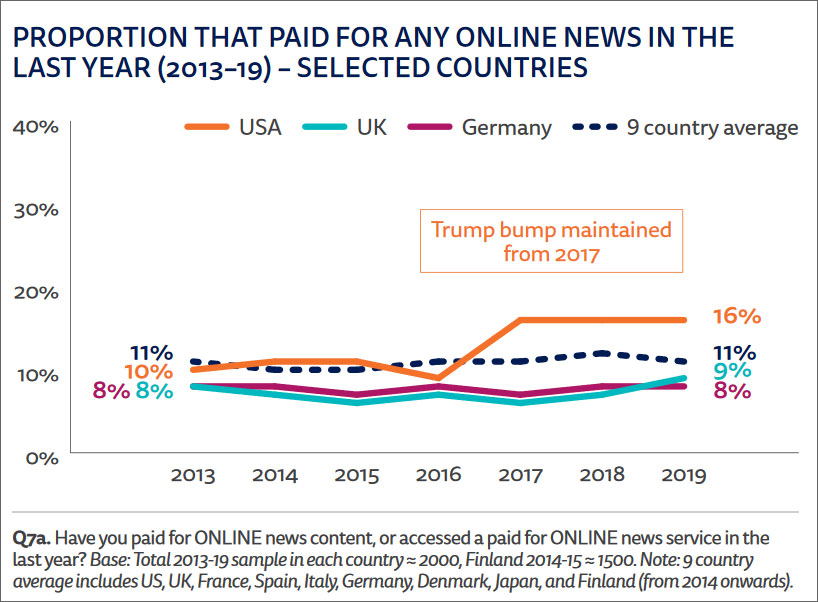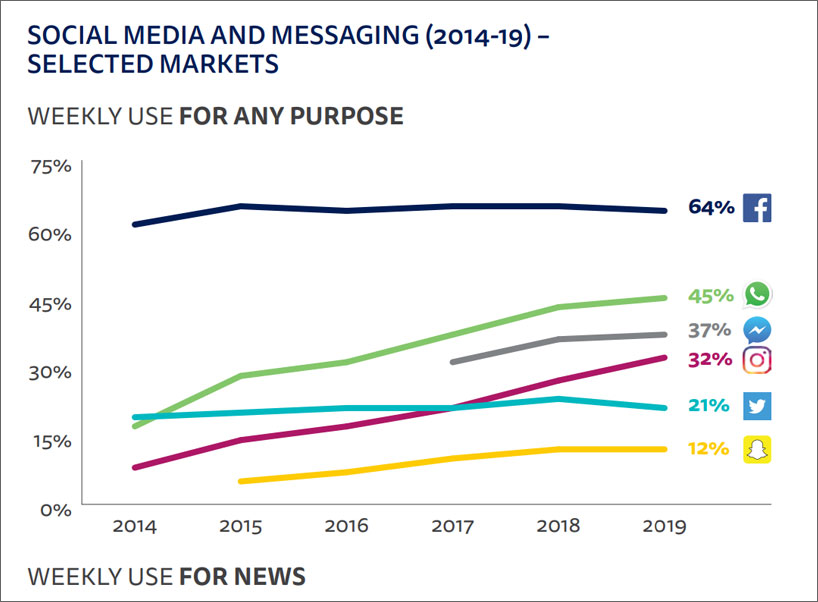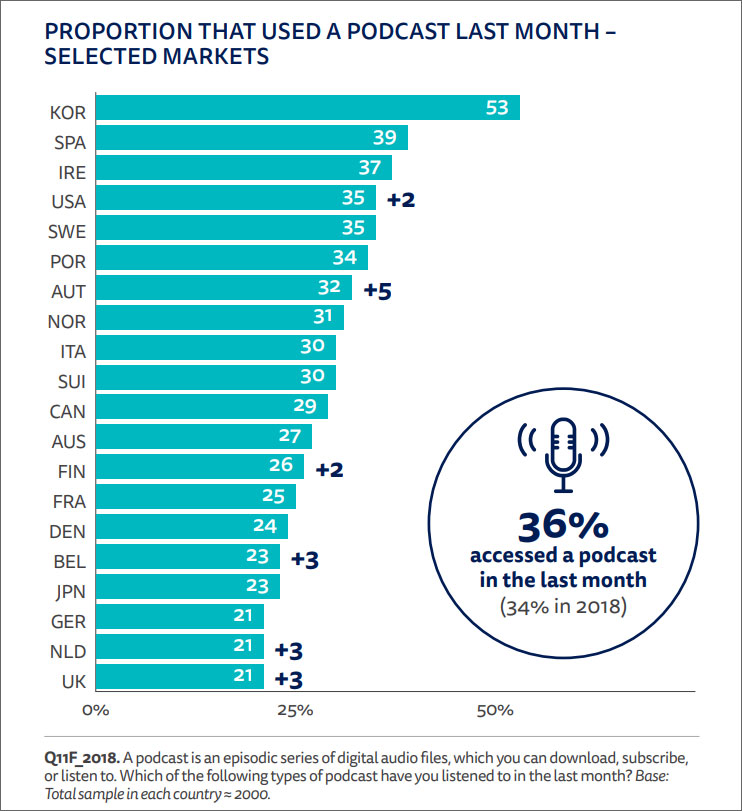
Digital News Report: News Aggregators, Messengers and Podcasts Win
The Digital News Report commissioned by the Reuters Institute gives an overview of recent developments in news consumption. Among the trends is the rise of audio formats, like podcasts and voice-activated speakers, as well as the use of messenger services for news content.
by Birgit Fingerle
The Reuters Institute Digital News Report 2019 has been commissioned by the Reuters Institute for the Study of Journalism to understand how news is being consumed. It was published in June 2019. The study was conducted by YouGov in 38 countries at the end of January/beginning of February 2019. In addition to the global report, there are also comprehensive country reports in national languages available for some of the countries. The Digital News Report covers a broad range of topics. We shed a light on some of them.
Smartphone is most convenient for news consumption
Though people are still using computers and tablets for news the smartphone tends to win out as their preferred device. Two-thirds (66%) of the respondents are now using the smartphone to access news weekly (+4pp). At the same time, the number of people starting each day with radio, TV, or print is declining for instance in the US and UK, while more people are reading online news – most of them via smartphones. In the UK, the smartphone won over TV (27%) as the main first gateway to news (28%).
The developments in media usage reflect developments in society at large. Some problems, that respondents see, are addressed in the report. Among them: Trust in the news which are found via search engines (33%) and social media is extremely low (23%), but remains stable. The effects of information overload are another problem: 28% of the respondents answered that there is too much news these days, a feeling which is partly caused by constant news updates and the impression of being bombarded with multiple versions of the same news story.
Willingness to pay for news is still limited
The number of people willing to pay for online news has only increased a little and the growth is limited to some Nordic countries (Norway 34%, Sweden 27%). Paying models comprise: by subscription, membership, or donation. The vast majority of people that are willing to pay do so for only one online subscription. Thus, the “winner takes it all” dynamics seem to be quite important.
Due to limited budgets, news subscriptions, usually for single titles, rivals with entertainment spending (Netflix/Spotify). When respondents under the age of 45 years were asked what online media subscriptions they would choose, if they could only have one, they answered:
- 37% Online video (e.g. Netflix, Amazon Prime)
- 15% Online music (e.g. Spotify, Apple Music)
- 7% Online news (e.g. New York Times , Le Monde)
Paying for news content based on donation models still makes up only a small percentage of the market. Another alternative, bundling and aggregation, is executed for instance by the

Despite the only small increase in the number of payments for online news, it is positively noted that most of them are now “ongoing’ payment”, while one-off payments have stagnated, although micropayment platforms like Blendle have been introduced .
Growing role of news aggregators
A significant, yet relatively modest, shift towards mobile news aggregators like Apple News and Upday , News Republic, and Flipboard can be found. Mobile aggregation is already majority behaviour in many parts of Asia. In the US Apple News now reaches more iPhone users (27%) than the Washington Post (23%). It should be noted that these news aggregators follow different business models: While Upday, Google News, and Flipboard on the one hand pass traffic directly to publishers, Apple News, and Yahoo! News on the other hand aim to become destinations themselves, republishing full stories in return for a share of revenues. As for example Apple News+ offers a single priced subscription for multiple premium titles for $9.99, more premium news publishers will probably think about offering access to multiple brands at a reasonable price soon too.
Use of social networks and messengers
Usage of social networks is also changing. Although Facebook remains by far the most important social network for news, people in many countries are spending less time using it. Instead they spend more time with WhatsApp, Facebook Messenger and newer social networks like Instagram which also offer private messaging features. WhatsApp, Facebook Messenger and other messaging apps like Viber, Telegram, and WeChat are used by 75% for any purpose among the respondents and by 31% for news. This is an increase of 8 percentage points from the study two years ago and shows thus that social communication around news is becoming more and more private.

While WhatsApp groups are more used for private conversations with friends, family, and colleagues, Facebook Groups generally are more about sharing experiences with less-known people. But WhatsApp usage differs a lot across countries. In countries like Brazil (53%), Malaysia (50%), and South Africa (49%) WhatsApp has become the primary network for discussing and sharing news (while only 9% in the UK, 6% in Australia, and just 4% in the United States). In these countries far more people are part of large WhatsApp groups with people they don’t know – a trend that might encourage the spread of misinformation. Public as well as private Facebook Groups discussing news and politics are popular in Turkey (29%) and Brazil (22%) but little used in countries like for instance Canada (7%).
Podcasts reach a critical mass
Due to the growth of the smartphone use, better content and easier distribution, podcasts still grow heavily in usage and are starting to reach a critical mass. Popularity of podcasts is especially high with the young. Among the participants one third (36%) had consumed a podcast in the last month (50% for those under 35), and almost one in six (15%) had consumed one on news, politics, or international news. During the last year for instance The Guardian, Washington Post, Politiken, AftenPosten, The Economist, and the Financial Times have launched daily podcasts, following the huge success of the New York Times’ Daily podcast. Smartphones are the most used device (55%) for podcast listening. Among the main reasons for listening to podcasts are keeping updated about personal interest topics (46%) and to learn something new (39%).

As commercial interests in podcasts gain traction, advertising becomes more intrusive and platforms like Spotify are paying for exclusive premium content. This raises some fears about podcasts losing their purity and authenticity.
Voice-activated speakers are looking for more news content
The reach of voice-activated speakers like the Amazon Echo and Google Home for any purpose has grown from 7% to 14% in the UK during the last year and from 9% to 12% in the US. Nevertheless, the proportion of users using smart speakers for news is declining.
Both Google and Amazon have launched in a lot of new markets including India, Spain, Mexico, and some Nordic countries in the last year. While Amazon has a dominant position in the US, UK, and Germany, Google leads for instance in Australia and Canada where it launched first.
For publishers the issue of platform power will probably become an increasingly important issue over the next year. Nevertheless, many are hesitant about helping to build value for the Google or Amazon platforms by providing more aggregated news services in voice, because they don’t see any path to monetization for their own organization.
Video news
Video news are mostly consumed on Facebook (32%) and YouTube (26%). While Facebook has lost a little in importance for news video over the last year, other platforms like Twitter, Instagram, and Snapchat became slightly more important.
Nevertheless more than one third (35%) of the report’s combined sample does not consume any online news video regularly, in the UK and Germany reaching an even higher 54%. In Turkey, with 83% of the report’s urban sample saying they have consumed news via offsite platforms; platforms like YouTube build an important centre of opposition media. Across all countries, a vast majority (68%) say they prefer news in text over video. Only, of the respondents under 35s a significant minority of 13% says it prefers video news.
View Comments

Open Access for Monographs: Small Steps Along a Difficult Path
While a considerable proportion of journal articles are now available in open access,...



